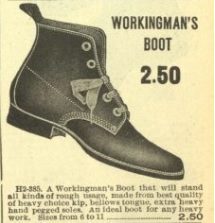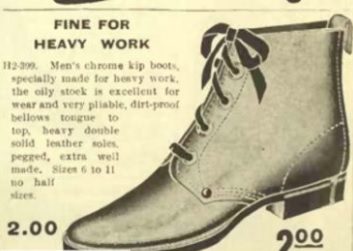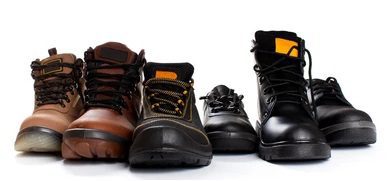
Are you looking to find which work boot is best that suits for your safety and requirement(s)? We think you have landed on the best possible place on Internet world . After reading this article, you will have a clear idea about the work boots, boot types, safety features and you will be able to pick the most suitable Work Boots that matches your taste, budget and requirements. This article will also lead you comprehensively to take your decisions for buying the pair of boots for your specific purpose or profession as well as weather conditions.
When The Work Boots were Invented?
The origin of work boots can be traced back to 17th century Europe. The first version was the jodhpur which are knee length leather shoes, with a metal shank in them and were mainly used by cavalry officers. Later on it became customary for workers who had to spend long hours standing or walking in wet conditions to wear rubber overshoes (Wellingtons) . These British style boots were called “boots”. They did not have laces and could only come up as far as the ankle because they lacked support from any other part of their design. It wasn’t until 1892 that Goodyear invented vulcanized rubber soles/heels which allowed people’s feet stay dryer than ever before while wearing these.
Invention of Safety Boots
The invention of boots and footwear for safety is tracked back to the early period of the 20th century, when industrial safety gear first became an issue. Before that, it was easier and way cheaper to just replace an injured worker than to put safety measures in action. It was not until the 1900s that companies began to realize they could make money by promoting safety.

Lumbermans Rubber Gum Boot (1900) 
Felt and Rubber Work Boot (1902) 
Working Boots (1907) 
Working Boots (1907) 
Lace Up Hunting Boots (1908) 
Heavy Work Boots (1909)
What are The Types of Work Boots
There are many different types of work boots available to buy based on design and construction, material and features.
Dimension Based Work Boot types
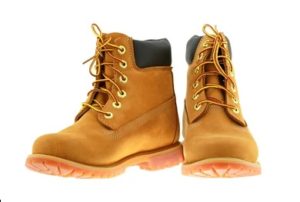
Six-inches Boots
Six-inches Boots are Best for Lumberjacks and they need to walk on rough path. It has a thick sole made of rubber or other flexible material so that it can provide enough comfort and protection with its strong grip surface. The upper part is usually leather, but not always the case. Generally this type of work boots protects against water penetration and provides more insulation from cold than any other types of work shoes.
Read Also : Best 6 inches Work Boots you can rely on

Eight-Inches Boots
Eight Inches Boots is Best for welders. The sole is made of a thick leather and stuffed with cork, shavings or other flexible material to provide insulation from heat. It has strong grip surface which provides more protection than any other types of work shoes against slipping on oily surfaces such as steel girder walkways. The upper part usually consists of leather but not always the case. Generally this type of boots protects water penetration and provides better insulation from cold than any other types of work shoes.
Read Also : Best 8 inches Work Boots you can rely on

Nine and Ten-Inches Boots
Nine and Ten-inches Boots are best for heavy equipment operators. They are Best for below freezing weather and provide protection from electric shock on machines such as an excavator or bulldozer, where electricity travels through the steel tracks. The upper part usually consists of leather but not always the case. Generally this type of boots has a strong grip surface which provides more protection than any other types of work shoes against slipping on oily surfaces such as steel girder walkways.
Read Also : Best 9 and 10 inches Work Boots you can rely on
Eleven-Inches Boots
11-inches Boots is Best for tar beach operation workers. This type of boot protects water penetration better than any other types of work shoe due to its deep tread pattern design in most cases they have side zippers that open up all around allowing easy removal when taking breaks during shift hours instead having to stop at every break just so you.
Read Also : Best 11 inches Work Boots you can rely on
Design and Construction Based Work Boots

Rubber Boots
Rubber work boots are the most common type of work boots. These are great for those who wish to avoid injury and want a safe option on their feet. The rubber protects from water, chemicals or cold weather which is ideal for people working with these things regularly like nurses, gardeners or construction workers. Rubber boots come in many styles but all have some kind of elasticized sides that keep your foot inside unless you’re actively taking them off, usually this style has more padding than other types due to its need for extra comfort when standing around all day long.
Read Also : Best Rubber Work Boots for everyday use

Slip-on/Pull-on Boots
Slip-on work boots are a type of safety footwear that can be put on and taken off without the use of any laces, buckles or other equipment. This is because they have elastic sides which hold them in place when not being worn. They do however usually add a little extra padding to the heel for comfort. This type of work boots has an average heat resistance thus best suit in outdoors environment where it’s hot most times but also cold from time to time as well, this boot protects water penetration better than any other types with its deep tread pattern design and due to side zippers which open up all around allowing easy removal during shift hours unlike having stop at every break just so you take.
Read Also : Best Slip-on Work Boots

Metatarsal Guard Boots
Metatarsal guard boots is Best Work boots for protection against specific hazards like heat, water or cold. These Best work boots are also used by those who have to walk on slippery surfaces and have a high risk of falling because its sole is made out of slip-resistant rubber materials. Metatarsal guard boots usually come in two types:
- Slip Resistant Rubber Sole with Side Metatarsal Guard
This Best Footwear prevents slipping while the side metatarsals provide additional foot protection from falls as well as slips that can lead to injury if not properly protected. They offer more stability than other Best footwear but some people prefer regular shoes over this type since it has less cushioning at the back heel area which may cause discomfort when walking long distances.
- Slip Resistant Rubber Sole with Full Metatarsal Guard
This Best Footwear protect the entire foot from slips and falls. These are Best for people who have a high risk of falling down due to heart problems or because of age. One disadvantage though, despite having more arch support than other boots, this type will not be able to offer as much cushioning at the heel area like regular shoes do which may make walking long distances uncomfortable. Other Best work footwear that protects against occupational hazards include
Read Also : Best Waterproof Work Boots

Steel Toe Boots
Steel toe boots are Best for people who work in hazardous working environments. These Best footwear are usually made of synthetic leather, a composite material or other Best materials that will not conduct electricity and offer protection against accidental contact with live electrical circuits like drywallers who need to climb ladders and lay sheets of metal studs.
Read Also : Best Steel Toe Work Boots

Alloy Toe Boots
Alloy Toe Boots are Best for people who work in environments that require Best footwear with protection against impact. These Best boots offer the best abrasion resistance and usually have a protective toe cap as well as steel mid-sole providing more safety than other Best Types of Work Boots.
Read Also : Best Alloy Toe Work Boots
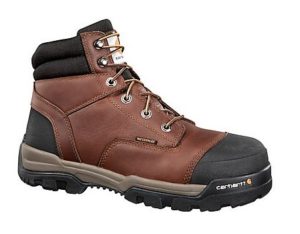
Composite Toe Boots
Composite Toe boots are made up of a high-density plastic material that is usually Best foam and formaldehyde free to make them more durable than other types of work boots. Composite Toe boots are best for the profession with Best risk of falling or Best work around heavy machinery.
Read Also : Best Composite Toe Work Boots

Plain Toe Boots
Plain Toe Boots are Best Work Boots that look like a typical Best Footwear, but they have beefed up protection on the foot and toes. It’s often recommended for people who aren’t exposed to heavy machinery or where there is no need for steel-toe protection, such as some office jobs. The Best Work Boot Plain Toe boots provide more comfort because it does not have any added construction in its design; however, this Best work boot lacks the best protective material in case of an accident and will cause serious injury if you are involved with sharp objects at your workplace.
Read Also : Best Plain Toe Work Boots
Feature Based Work Based

Conductive Boots – For Electrical Hazard
Conductive material boots are made with materials like rubber or PVC that resist the flow of electricity. These are designed to offer protection against electric shock when working on live electrical equipment, which is a common risk in some industries such as construction and manufacturing. Best part is, these kinds don’t need to be removed before entering wet areas and still offer protection against other dangers on the ground like sharp debris or chemicals and you can keep them on while working outside in inclement weather too.
A major downside for conductive work boots though? They’re not fire resistant at all!
Read Also : Best Conductive Work Boots you can rely on

Slip Resistant Boots
Slip Resistant or Anti-slip boots are designed to provide traction on slick surfaces so you can stay upright and keep working. Best part? These are great for work in wet environments like construction sites or farms with a lot of standing water that can come up over the top of boots. A major downside though is that many people find slip-resistant boots hard to walk on because their soles don’t provide much traction when dry – remember these will be worn in slippery mud or surfaces made from oily sludge which doesn’t grip well at all!
Read Also : Best Anti-slip Work Boots
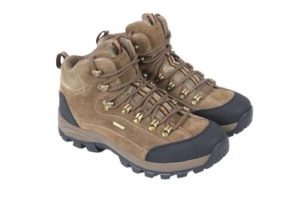
Waterproof Boots
Waterproof boots are designed to resist water, snow, and other moisture. These are great for work in wet environments like construction sites or farms with a lot of standing water that can come up over the top of boots. Best part? They’re designed to keep feet dry so they stay warm too! A major downside though is that many people find waterproof boots hard to walk on because their soles don’t provide much traction when wet – remember these will be worn in slippery mud or surfaces made from oily sludge which doesn’t grip well at all! The process of making work boots waterproof can be DIYed at home too.
Read Also : Best Waterproof Work Boots
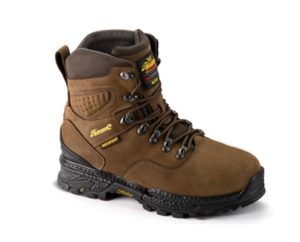
Insulated Boots
Insulated Boots will provide warmth and protection in cold environments. They are usually made with a fabric lining like wool, or leather to keep your feet warm on the inside while also providing some water-resistance. Insulated boots can be great for work that requires outdoor exposure during winter months because they will help you maintain dexterity even if its 20 degrees below zero outside! The downside though is that insulated boots may not have as much breathability as other options so it’s important to take breaks when needed – especially with Best Work Boots heated by your body (sounds awesome!)
Read Also : Best Insulated Work Boots
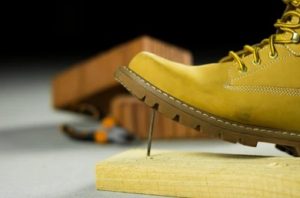
Puncture Resistant Boots
Puncture Resistant Boots are Best Work Boots for those who do work in an environment where their feet may be at risk of puncture or injury. They are usually made with a hard protective outer layer, and some even have steel toes to help protect your feet from heavy objects that could cause serious injury. Puncture Resistant boots come in different heights whether you’re looking for something shorter just above the ankle to provide more protection around the calf area, or taller options like Best Work Boots Steel Toe Booties which will offer full shin protection but can restrict movement if they don’t also have laces. Puncture Resistant Best Work Boots should only be worn by people whose work entails contact with sharp objects and moving machinery because thought it is more comfortable to wear, it may not protect your feet as much.
Read Also : Best Puncture Resistant Work Boots
Which Work Boot is Best for You : Selecting the Most Suitable Pair
We Recommend you to follow 3 simple steps to find out the most suitable Work Boots for you which will meet all your requirements yet will be within your budget.
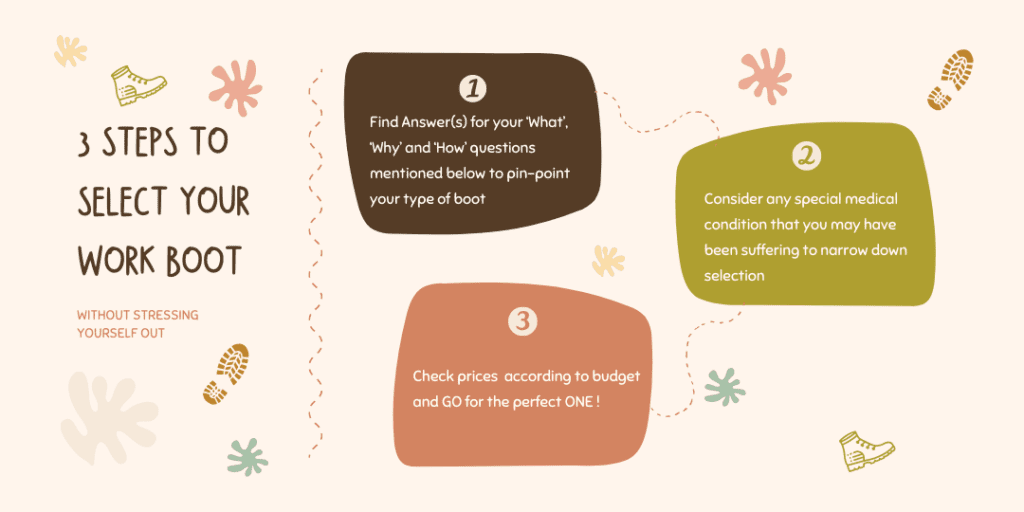
Step-1 : Find The Answer
| The Question | Best Fit Work Boots |
|---|---|
|
Where do you work? indoors or outdoors? | Answer More |
|
How many shifts are there in a day? | Answer More |
| Do you have chances of injury from dropped items at your workplace? | Steel Toe, Composite Toe |
| Do you work with sharp objects cluttered on the ground that could potentially permeate the bottom of your footwear? | Anti-Puncture |
| Do you have chances of injury from falling or rolling items posture a hazard of squashing or harming your feet? | Metatarsal Protection |
| Are you working with equipment with sharp blades that could perhaps cut your footwear, e.g. a power saw? | Special Saw Boots |
| How you’ll describe the surface of your workplace? (dry pavement/wet concrete/dirt/sand/gravels etc.) | Answer More |
|
Is your work environment is often damp? | Waterproof |
| Are surfaces often covered in water, oil, or other slippery compounds? | Anti-slip |
|
Do you work with chemical materials or acids in your workplace? | Rubber, Waterproof |
| Do you work in such a way that could cause an abrupt twist or sprain of the ankle joint? | Shock Absorber Heels |
|
Do you work in high temperatures or with molten steel? | Foundry Boots |
| Do you work in incredibly cold temperatures? | Insulated |
| Do you work with compounds that could create skin irritability? | Rigger Boots |
| Do you work in healthcare sector or any other fields where you have high chances of coming in contact with harmful biohazards? | Easy Clean Machine washable |
| Do you remain on your feet for long term? | Comfortable Sole, Shock Absorber Heel |
Step-2 : Consider Special Medical Condition(s) [if any] Before Selecting Work Boots

If you have a medical condition, like back pain, knee/ankle injury, diabetes or neuropathy, then it can be difficult to find the right work boot. This is because your feet may change shape and size due to these conditions. Under such circumstances, it is very important to find the most suitable work boots meeting your needs to keep it safe for those with sensitive feet, as well as give you ultimate protection. Some common medical conditions to consider before buying work boots are:
- Ankle Injury
- Knee Injury
- Back Pain
- Meniscus Tear
- ACL Tear
- Diabetes
- Neuropathy
- Wide/Narrow/Flat Feet
- Leather Allergy
There are specific and prescribed work boots with special medical features if you have one or more of the above mentioned medical conditions. We have a detailed article about selecting work boots if you have medical conditions which will further narrow your choices down and you can proceed to the final step then.
Step-3 : Find Out the Best Place to Buy Work Boots According to Your Budget

A good pair of work boots is an investment. It can make or break your day, so it’s important to take the time to find the right ones for you.
Sometimes it can be difficult to know where to go and what brands offer good quality. You need to have idea from where you need to buy work boots and how they are rated by people in terms of price, comfort level, durability and more! What’s more, you’ll need to select the right kind for your job and environment. Once you find the golden one, just go for it!
Here is a short yet interesting video by ASC Process Systems regarding choosing the right work boots for you:
Last Words
Whether you’re a construction worker, athlete or landscaper, the right work boots can make your day-to-day life much more pleasant. But with so many options on the market and different considerations for each type of profession, it’s not always easy to know which pair is best for you. Let this guide help you figure out what’s important in your line of work and how to find good quality shoes that fit both your budget and needs!






